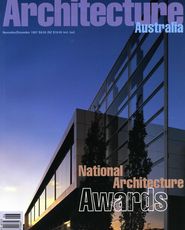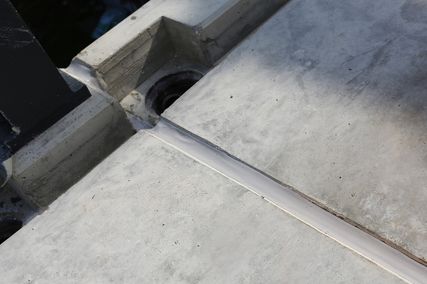| Neo Metro combine Asian and industrial influences at Tho Tho, a Vietnamese restaurant in Melbourne’s Richmond. Report by Norman Day. If ever the design of a place should deal with the senses, it is with a restaurant. It should smell of the cuisine, taste of the kitchen, ring with the sounds of creating the food and present a visual treat appropriate to the cook’s intentions. The floors, walls and fabric of the place should feel as promised; it is possible to create quite meaningful intentions by design at this level. |
| Tho Tho is an institution in Melbourne, it has been there, it seems, forever: the restaurant offers quick, inexpensive and fresh food in a strip of like-minded cafés. Victoria Street, Richmond, is often packed with busy people buying fresh vegetables, cakes, big bags of rice, offal and skinny chickens. This is Little Vietnam, where we are beneficiaries of a spectacular culture which has flooded us with migrants since the devastating war of the 1960s. The smells of the street and the sounds of a musical language resonate across the shops and cafés. |  Ground floor dining with bluestone column and red ceiling blade. |
| Neo Metro are good architects. They have a house style of textural, solid-and-void forms built using rendered sand-finish walls, steel, glass and metals. It is clever, gentle, professionally innovative design, Modern but not too much, detailed sharp but not cutting-edge, shapely and textured but not theoretically challenging. The public loves them.
Tho Tho has some of those qualities: there is a polished concrete floor, sand-rendered walls, big sheets of glass, and the exterior wall of their extension to the restaurant is mannered with opaque glass, timber screens and black walls—it could be a young estate agents’ office. | |
 left Seen across the ground floor dining area, a bar of stained veneer, stainless steel and white Hytex composite. | But it isn’t. The interior keeps that pattern, along with vaulted red and silver/white ceilings, a bar composed of black boxes and white infill, and a wonderfully gaudy collection of ‘chip’ chairs coloured like a sea of flowers—blue, red, purple, green, yellow, black … the lot. On one wall are propped black totem poles by Bruce Armstrong, which give the feel of a museum rather than a loudly living eating institution.
Vietnamese culture in Australia is more in-your-face than this: it is bright red, lots of gold, shiny and very colourful. |
| Yet the design seems to miss the point of Tho Tho’s offerings. The restaurant sings with hurried waiters carrying small plates of food and rice at remarkable pace, spurting our their musical lingo; children wander over the place as if it’s their home, in the way of all good Asian restaurants; people sit in animated groups tapping on the table with their chopsticks—or alone reading the paper over a $3 soup.
Vietnamese food comes in a variety of guises. I like the transparent wrapped vegetable rolls where the carrots, leaves and rice can be spied under the skin, or the simple clump of green raw lettuce, or the floating wonton soup with its green, red, brown and white floaters. The smells are coriander, complex mixtures of Vietnamese mints and teas, light on the chilli and delicate on the meats. Tables are set up with brand-name chilli jars, bottled soy sauce and plastic sauce bottles. | |
| One huge benefit for the place is its large glass areas which bring the neighboring buildings into the design. A lurid ultramarine wall shines through the east glass wall and the buzz of Victoria Street, lit to bursting point at night, shines in.
It would be fascinating to see those characteristics in the architecture. I would like to have seen a restaurant with the idiosyncrasies of Vietnamese cooking and culture—transparency, opaqueness, lightness, natural color, fluidity, noise and clatter. |  New exterior treatment for the former Victorian pub: facade finishes include opaque glass, cedar battens and metal fins. |
| Tho Tho, Richmond, Victoria Architects Neo Metro—project team Jeff Provan, Barry Ludlow, Clare McAllister, Joe O’Dwyer, Marie Manakis, Karen McWilliam, Sarah Naarden. Clients Ho and Lee Chi Van. Builder Neocon. Graphics Marcus Lee Design. Sculptures Bruce Armstrong. Chairs ‘Classic’ from MID. Engineer BCM. Photography Peter Clarke. Norman Day is a Melbourne architect and writer who is an adjunct professor at RMIT’s Faculty of the Constructed Environment. | |















